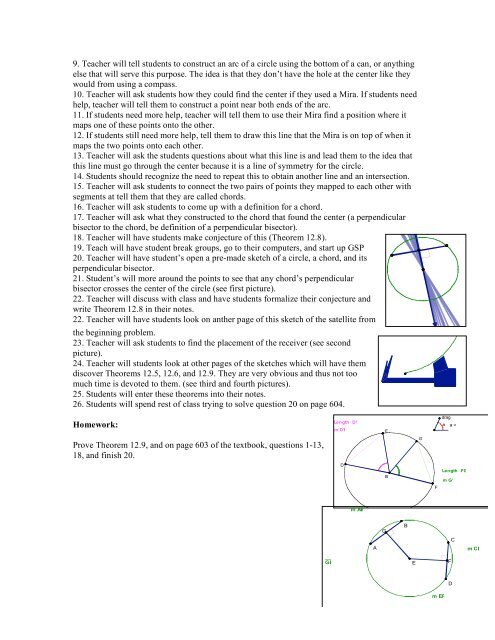The Geometry of a Circle - By: Dennis Kapatos
The Geometry of a Circle - By: Dennis Kapatos
The Geometry of a Circle - By: Dennis Kapatos
You also want an ePaper? Increase the reach of your titles
YUMPU automatically turns print PDFs into web optimized ePapers that Google loves.
9. Teacher will tell students to construct an arc <strong>of</strong> a circle using the bottom <strong>of</strong> a can, or anything<br />
else that will serve this purpose. <strong>The</strong> idea is that they don’t have the hole at the center like they<br />
would from using a compass.<br />
10. Teacher will ask students how they could find the center if they used a Mira. If students need<br />
help, teacher will tell them to construct a point near both ends <strong>of</strong> the arc.<br />
11. If students need more help, teacher will tell them to use their Mira find a position where it<br />
maps one <strong>of</strong> these points onto the other.<br />
12. If students still need more help, tell them to draw this line that the Mira is on top <strong>of</strong> when it<br />
maps the two points onto each other.<br />
13. Teacher will ask the students questions about what this line is and lead them to the idea that<br />
this line must go through the center because it is a line <strong>of</strong> symmetry for the circle.<br />
14. Students should recognize the need to repeat this to obtain another line and an intersection.<br />
15. Teacher will ask students to connect the two pairs <strong>of</strong> points they mapped to each other with<br />
segments at tell them that they are called chords.<br />
16. Teacher will ask students to come up with a definition for a chord.<br />
17. Teacher will ask what they constructed to the chord that found the center (a perpendicular<br />
bisector to the chord, be definition <strong>of</strong> a perpendicular bisector).<br />
18. Teacher will have students make conjecture <strong>of</strong> this (<strong>The</strong>orem 12.8).<br />
19. Teach will have student break groups, go to their computers, and start up GSP<br />
20. Teacher will have student’s open a pre-made sketch <strong>of</strong> a circle, a chord, and its<br />
perpendicular bisector.<br />
21. Student’s will more around the points to see that any chord’s perpendicular<br />
bisector crosses the center <strong>of</strong> the circle (see first picture).<br />
22. Teacher will discuss with class and have students formalize their conjecture and<br />
write <strong>The</strong>orem 12.8 in their notes.<br />
22. Teacher will have students look on anther page <strong>of</strong> this sketch <strong>of</strong> the satellite from<br />
the beginning problem.<br />
23. Teacher will ask students to find the placement <strong>of</strong> the receiver (see second<br />
picture).<br />
24. Teacher will students look at other pages <strong>of</strong> the sketches which will have them<br />
discover <strong>The</strong>orems 12.5, 12.6, and 12.9. <strong>The</strong>y are very obvious and thus not too<br />
much time is devoted to them. (see third and fourth pictures).<br />
25. Students will enter these theorems into their notes.<br />
26. Students will spend rest <strong>of</strong> class trying to solve question 20 on page 604.<br />
?<br />
Homework:<br />
Length D'E on<br />
m D'E = 4.83 cm<br />
BC = 5.13 cm<br />
E<br />
drag<br />
a a = 68.76 °<br />
Prove <strong>The</strong>orem 12.9, and on page 603 <strong>of</strong> the textbook, questions 1-13,<br />
18, and finish 20.<br />
G'<br />
D'<br />
B<br />
Length FG' on BC =<br />
m G'G = 4.83 cm<br />
F<br />
m AB = 3.27 cm<br />
G<br />
B<br />
C<br />
A<br />
m CD = 3.3<br />
m GE = 3.09 cm<br />
E<br />
F<br />
D<br />
m EF = 3.06 cm

















